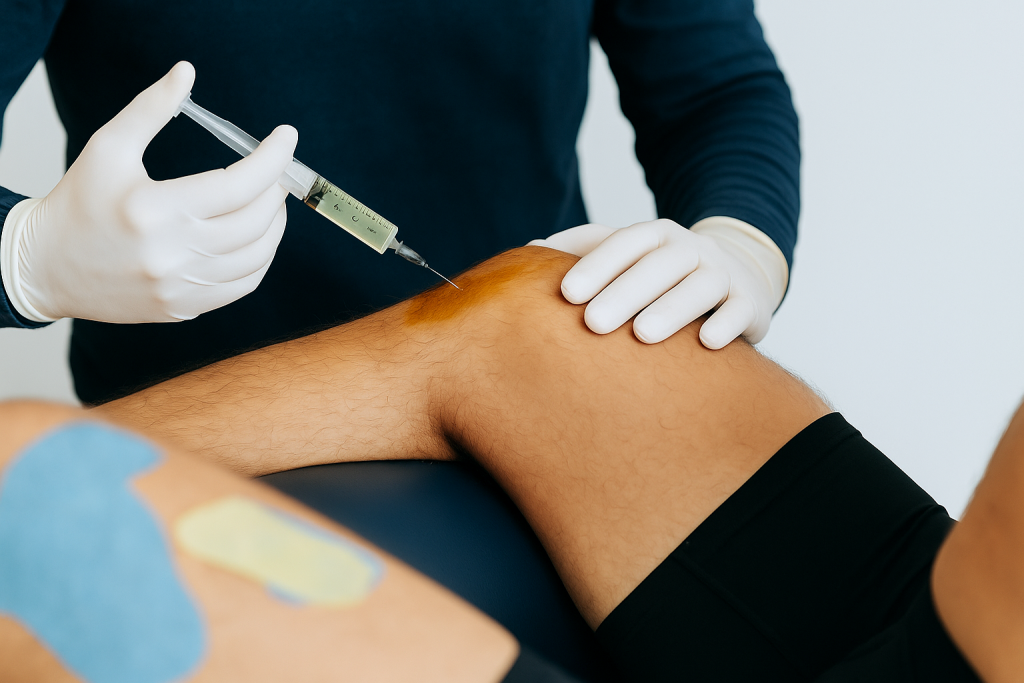A New Era in Regenerative Medicine for Osteoarthritis and Chronic Knee Injuries
Chronic knee pain is one of the leading causes of functional disability in adults. Osteoarthritis—a progressive degenerative condition affecting the articular cartilage—along with other chronic injuries such as patellofemoral syndrome or repetitive microtraumas, severely impacts the quality of life of millions of people worldwide.
In this landscape, modern medicine faces the challenge of offering treatments that go beyond symptom relief to provide true tissue restoration. This is where three cutting-edge therapeutic tools converge: platelet-rich plasma (PRP), hyaluronic acid (HA), and ultrasound-guided precision injections. Together, they represent a paradigm shift in how chronic knee pain is treated.
🌿 Regenerative Medicine: Beyond Pain Relief, Toward Functional Restoration
The regenerative approach radically departs from traditional symptom-based models. Its core objective is to modify the joint microenvironment, activate the body’s intrinsic repair mechanisms, and promote more complete structural and functional recovery.
Rather than simply blocking inflammation (e.g., with corticosteroids) or lubricating the joint with HA alone, regenerative therapies aim to:
- Stimulate angiogenesis
- Promote chondrocyte proliferation
- Modulate the immune response
- Remodel the extracellular matrix
This minimally invasive, image-guided outpatient strategy is especially valuable in early to moderate osteoarthritis, where conventional pharmacological interventions often fail and surgery is not yet the only option.
🩸 PRP (Platelet-Rich Plasma): Internal Repair Stimulated Naturally
PRP is a biologic solution derived from the patient’s own blood, rich in platelets and growth factors such as PDGF, TGF-β, VEGF, and EGF. These molecules serve as biological signals that:
- Reduce chronic low-grade inflammation
- Stimulate type II collagen synthesis
- Promote mesenchymal stem cell proliferation and differentiation
- Enhance tissue revascularization
When injected into the joint, PRP creates a regenerative environment capable of slowing or even reversing degenerative changes, particularly in the early to moderate stages of joint disease.
💧 HA (Hyaluronic Acid): Lubrication, Joint Support, and Synergy with PRP
HA is a naturally occurring component of synovial fluid that provides essential viscoelasticity for joint mechanics. With aging or chronic wear, its levels decrease—reducing lubrication and accelerating degeneration.
Intra-articular HA injections help restore joint biomechanics and reduce mechanical pain. However, when combined with PRP, the therapeutic impact is amplified:
- Increases PRP retention within the joint
- Prolongs the release of growth factors
- Optimizes anti-inflammatory and chondroprotective effects
🧠 Ultrasound Guidance: Millimetric Precision for Maximum Effectiveness
In regenerative medicine, precision is as critical as the substance injected. Real-time ultrasound guidance has transformed joint injection practices. Compared to blind techniques, ultrasound allows clinicians to:
- Visualize joint structures, vessels, and nerves in real time
- Accurately deliver PRP or HA into intra- or periarticular spaces
- Tailor procedures to individual anatomy
- Avoid misplacement, bleeding, and complications
Ultrasound guidance enhances clinical success rates and turns each injection into a minimally invasive, image-guided micro-procedure.

🔍 Scientific Evidence and Clinical Outcomes
Numerous clinical trials and systematic reviews have shown that the combined use of PRP and HA, guided by ultrasound:
- Significantly improves functional scores (WOMAC, KOOS)
- Reduces pain by 60–80% in grade I–III osteoarthritis
- Decreases reliance on NSAIDs and analgesics
- Slows osteoarthritis progression
- Reduces the need for joint replacement in early stages
👤 Who Are Ideal Candidates for This Approach?
This approach is particularly suitable for:
- Patients with mild to moderate osteoarthritis avoiding surgery
- Younger adults with chondral injuries or repetitive joint stress
- Older adults intolerant to NSAIDs or with complex conditions
- Athletes with chronic joint issues or post-surgical pain
- Individuals with persistent pain after conventional treatment
🧩 Integration Into a Multidisciplinary Care Model
Joint regeneration should not be seen as a standalone procedure but rather as part of a comprehensive therapeutic strategy, which includes:
- Specialized physical therapy
- Adjunctive modalities such as laser therapy, shockwave therapy, or mechanical joint decompression (Knee On Trac)
- Functional biomechanical evaluation
- Patient education for weight control, adherence, and guided movement
🏁 Conclusion: A Bridge Between Present-Day Medicine and the Future
Regenerative therapies, combined with high-precision imaging technologies, offer not just real hope for patients with chronic knee pain, but an evolution in how joint disease is understood and treated.
Rather than accepting joint deterioration or opting for early surgical interventions, we now have the ability to stimulate the body to heal itself, using techniques that are safe, effective, and biologically sound.
At our clinic, we are proud to offer these advanced solutions—merging science, clinical expertise, and a long-term commitment to joint health.
